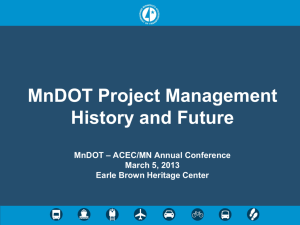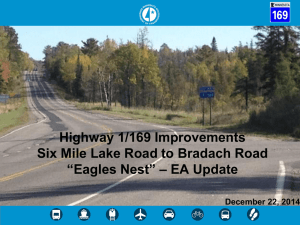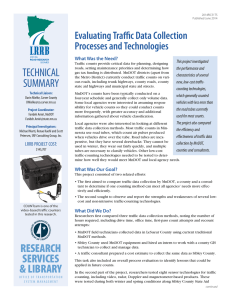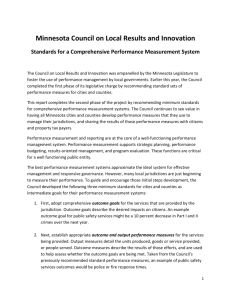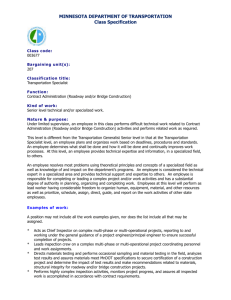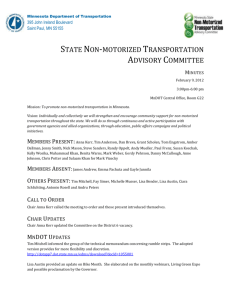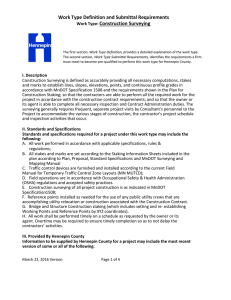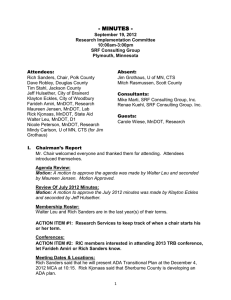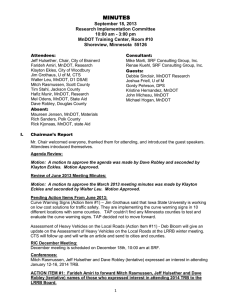TECHNICAL Putting Research into Practice: Safety Strategies for Local Agencies
advertisement
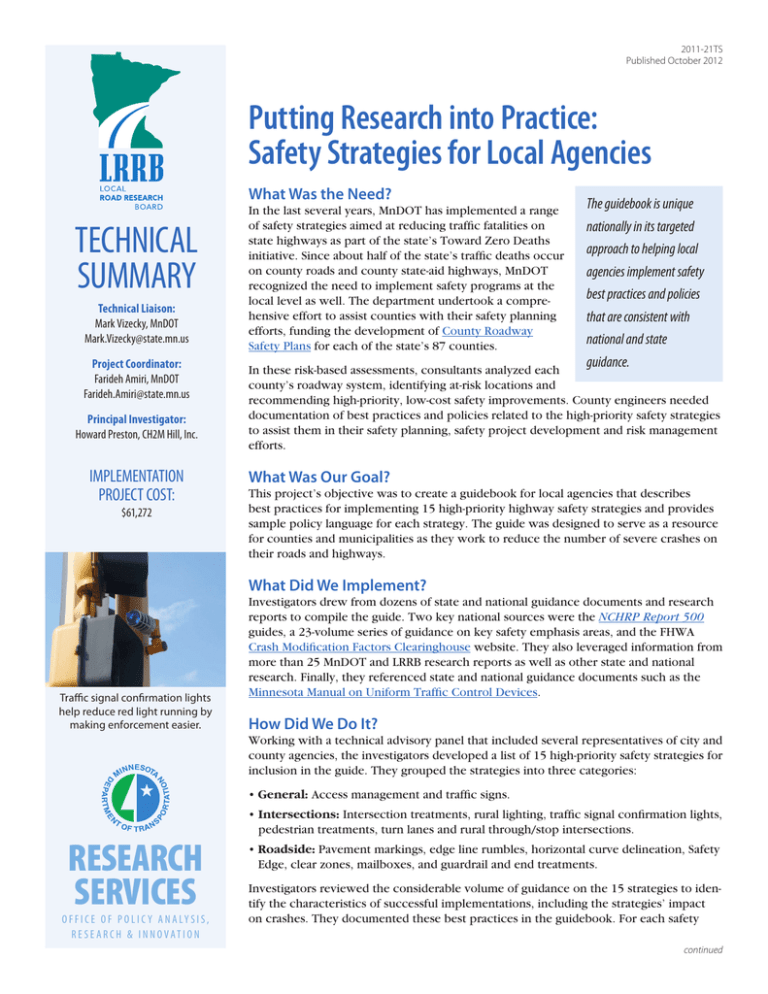
2011-21TS Published October 2012 Putting Research into Practice: Safety Strategies for Local Agencies What Was the Need? TECHNICAL SUMMARY Technical Liaison: Mark Vizecky, MnDOT Mark.Vizecky@state.mn.us Project Coordinator: Farideh Amiri, MnDOT Farideh.Amiri@state.mn.us Principal Investigator: Howard Preston, CH2M Hill, Inc. IMPLEMENTATION PROJECT COST: $61,272 In the last several years, MnDOT has implemented a range of safety strategies aimed at reducing traffic fatalities on state highways as part of the state’s Toward Zero Deaths initiative. Since about half of the state’s traffic deaths occur on county roads and county state-aid highways, MnDOT recognized the need to implement safety programs at the local level as well. The department undertook a comprehensive effort to assist counties with their safety planning efforts, funding the development of County Roadway Safety Plans for each of the state’s 87 counties. The guidebook is unique nationally in its targeted approach to helping local agencies implement safety best practices and policies that are consistent with national and state guidance. In these risk-based assessments, consultants analyzed each county’s roadway system, identifying at-risk locations and recommending high-priority, low-cost safety improvements. County engineers needed documentation of best practices and policies related to the high-priority safety strategies to assist them in their safety planning, safety project development and risk management efforts. What Was Our Goal? This project’s objective was to create a guidebook for local agencies that describes best practices for implementing 15 high-priority highway safety strategies and provides sample policy language for each strategy. The guide was designed to serve as a resource for counties and municipalities as they work to reduce the number of severe crashes on their roads and highways. What Did We Implement? Traffic signal confirmation lights help reduce red light running by making enforcement easier. Investigators drew from dozens of state and national guidance documents and research reports to compile the guide. Two key national sources were the NCHRP Report 500 guides, a 23-volume series of guidance on key safety emphasis areas, and the FHWA Crash Modification Factors Clearinghouse website. They also leveraged information from more than 25 MnDOT and LRRB research reports as well as other state and national research. Finally, they referenced state and national guidance documents such as the Minnesota Manual on Uniform Traffic Control Devices. How Did We Do It? Working with a technical advisory panel that included several representatives of city and county agencies, the investigators developed a list of 15 high-priority safety strategies for inclusion in the guide. They grouped the strategies into three categories: • General: Access management and traffic signs. RESEARCH SERVICES O F F I C E O F P O L I C Y A N A LY S I S , R E SE A R C H & I N N OVAT I O N • Intersections: Intersection treatments, rural lighting, traffic signal confirmation lights, pedestrian treatments, turn lanes and rural through/stop intersections. • Roadside: Pavement markings, edge line rumbles, horizontal curve delineation, Safety Edge, clear zones, mailboxes, and guardrail and end treatments. Investigators reviewed the considerable volume of guidance on the 15 strategies to identify the characteristics of successful implementations, including the strategies’ impact on crashes. They documented these best practices in the guidebook. For each safety continued “The guidebook gets critical information on traffic safety strategies into the hands of city and county engineers who may not have a background in safety. This project was driven by local agencies asking for more safety information.” —Howard Preston, Senior Transportation Engineer, CH2M Hill, Inc. The best practices guide helps local agencies determine when to implement safety strategies such as curb extensions, which reduce the width of the roadway, make pedestrians more visible in the crosswalk and encourage vehicles to slow down. “This is the first time a comprehensive approach to implementing traffic safety strategies has been put together for local agencies. The sample policies are geared toward the way cities and counties conduct business.” strategy, the guidebook describes safety benefits, effectiveness, typical costs, candidate locations, design features and impact on roadway operations, and provides citations to related research and data. Each section includes a list of source materials that local agencies can consult for more information as they implement the strategies. —Mark Vizecky, The sample policy language gives local agencies a framework for drafting their own policies for implementing the strategies. Establishing safety policies can help local agencies explain engineering decisions to the public and can provide documentation to help limit agencies’ exposure to legal claims. MnDOT State Aid Program Support Engineer Finally, researchers developed sample policy language for each strategy that can be customized by local agencies. What Was the Impact? The best practices guide is a valuable resource for local agencies, providing tools to support their safety planning and policy development. The guide is unique nationally in its targeted approach to helping local agencies implement safety best practices and policies that are consistent with national and state guidance. As a component of MnDOT’s statewide highway safety planning efforts, the guide has helped create a culture of safety planning at the local level in Minnesota. Ultimately, the implementation of the best practices and policies in the guide is expected to reduce severe crashes and save lives. What’s Next? Produced by CTC & Associates for: Minnesota Department of Transportation Research Services MS 330, First Floor 395 John Ireland Blvd. St. Paul, MN 55155-1899 (651) 366-3780 www.research.dot.state.mn.us MnDOT has distributed the guidebooks to all 87 counties and to more than 140 cities in Minnesota, providing outreach and training to encourage and facilitate the guide’s use. In addition, the Minnesota Local Technical Assistance Program is using the guide to modify the content of its tort liability training course. The guide’s format has been well received, and a related research project is under way to produce a similar best practices guide on bicycle and pedestrian treatments. This Technical Summary pertains to the LRRB-produced Report 2011-21, “Minnesota’s Best Practices and Policies for Safety Strategies on Highways and Local Roads,” published September 2011. The full report can be accessed at http://www.dot.state.mn.us/research/documents/201121.pdf. The resources cited as source material for this guide include the NCHRP Report 500 guides and the FHWA Crash Modification Factors Clearinghouse website.

